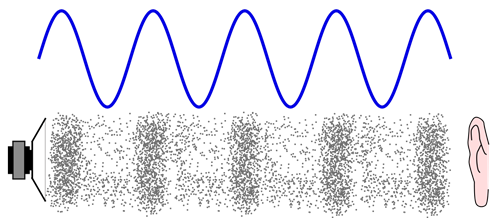PDF chapter test TRY NOW
In our daily life, we hear different sounds from different sources like birds, animals and humans. Sound energy is a form of energy which enables our ears to hear something around us.
One can create sound, but we learnt energy can neither be created nor destroyed; energy can only be transferred or changed from one form to another.
Then how sound is created?
Sound energy is not created; it is transferred from one form of energy to another.
There are three kinds of energy,
- Mechanical energy
- Light energy
- Heat energy
Example:
When you clap with your hands the sound is produced, but the mechanical energy is converted into sound energy.
Production of sound:
A sound is always produced by a vibrating body. Sound cannot be produced without any vibration. The SI unit for expressing the loudness of a sound is decibel (dB).
What is vibration?
When a body moves to and fro, or up and down, about a fixed position, it is said to be in oscillatory motion. A body exhibiting a rapid oscillatory motion is said to be in vibration.

When we strike the tuning fork with any object, it will start to vibrate; thus, the vibration travels through the medium and reaches our ears. Therefore, we can hear the sound produced by the tuning fork.
Important!
Medium:
A substance through which energy of some kind can travel.
Example:
Solid, liquid, gas.
Propagation of sound:
- When an object vibrates, it sets the particles of the medium around it in vibrations.
- The medium could be a gas, liquid or solid.
- Sound travels in a medium by disturbing the particles of the medium to vibrate from a point. Therefore, sound always has a starting point and an ending point.
- When you talk to someone, the particles in the air get displaced due to the pressure caused by the sound you produce. Then, they replace the adjacent particles, and it continues. In this way, a sound travels.
- Therefore, we conclude that the particles of a medium do not travel from one point to another to propagate sound. Sound propagates because of the disturbance caused by a source of sound in the medium, and it travels in the form of waves. Thus, the sound is called as mechanical waves.
- Sound cannot travel in a vacuum because sound waves always need molecules of some kind to travel in a given space.

Compression and Rarefaction:
When a vibrating object moves forward in the air, it pushes the air and compresses it. When the object moves backwards, it creates a rarefaction.
Compression is the part of a longitudinal wave in which the particles of the medium are closer to one another, and it is in the region of high pressure. Compression is denoted by letter C.
Rarefaction is the part of a longitudinal wave in which the particles of the medium are farther apart and thus the region in low pressure. Rarefaction is denoted by letter R.
Reference:
https://commons.wikimedia.org/wiki/File:CPT-sound-physical-manifestation.svg
